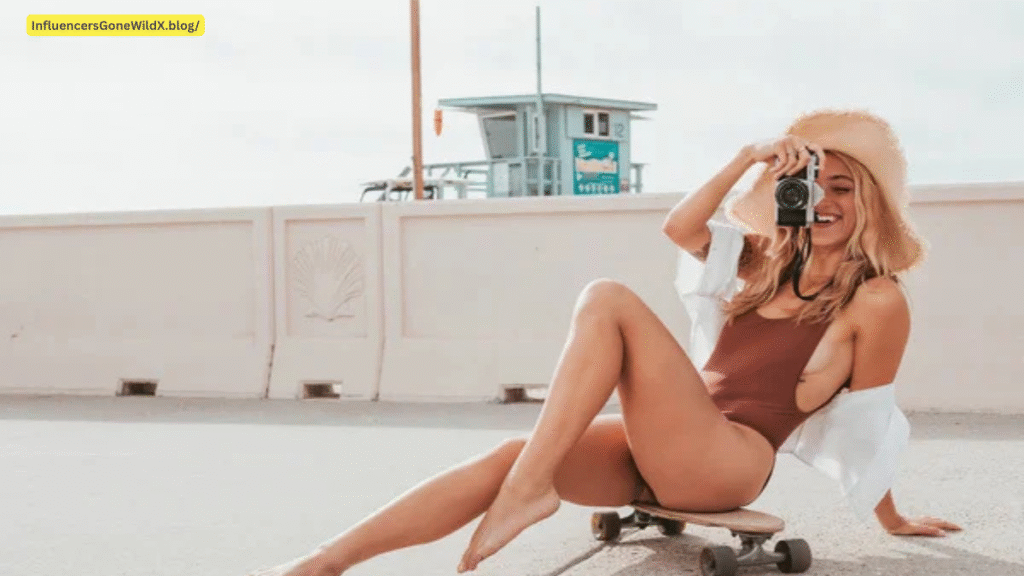📈 The Evolution of Influence: From Authenticity to Absurdity
In the beginning, Influencers Gone Wild were seen as the digital era’s pioneers of relatability. They were the faces behind filters, sharing raw moments, product reviews, or niche expertise. It felt intimate and genuine. But that sincerity, over time, collided with capitalism. As platforms evolved, algorithms changed, and brand sponsorships exploded, many Influencers Gone Wild felt the pressure to stand out—at any cost.
Now, the line between authentic content and orchestrated chaos is thinner than ever. Influencers Gone Wild aren’t just creators anymore; they’re performers in a high-stakes digital coliseum. And when performance becomes performative, “going wild” often follows.
In this context, “Influencers Gone Wild” isn’t just about outrageous behavior; it’s about what happens when the internet’s most followed figures lose control of their narratives—either deliberately for views or unintentionally through missteps.
Influencers Gone Wild today often walk the tightrope between virality and vulnerability. Some rise by sharing thoughtful perspectives or artistic content. Others explode into fame overnight due to controversial antics. Either way, the chase for digital relevance is unforgiving. This culture shift has made the influencer space a breeding ground for extreme content, constant reinvention, and at times, self-destruction.
🔥 Defining “Influencers Gone Wild”: Beyond the Clickbait
To the casual viewer, the phrase might evoke scandalous behavior. But in the influencer realm, it represents a broader spectrum of online disarray: emotional breakdowns, fake relationship dramas, tone-deaf promotions, or dangerous viral challenges.
One defining characteristic of these incidents is their virality. It’s no longer enough to be funny, smart, or stylish. Wild behavior draws faster engagement. Why? Because digital audiences thrive on spectacle. The influencer’s descent becomes community theater.
Even worse, some creators now weaponize vulnerability—posting teary videos, staging conflict, or exaggerating mental health issues—not to heal, but to harvest clicks. It’s the dark side of digital fame, one that leaves both Influencers Gone Wild and followers emotionally fatigued.

Today, going Influencers Gone Wild also means going beyond norms. We’ve seen Influencers Gone Wild announce fake pregnancies, create intentionally offensive content, or livestream family fights just to capture attention. These acts, though disturbing, often receive more engagement than quality content. It’s an environment where clicks become currency, no matter the cost.
🔍 Wild Case Studies: When Things Fell Apart
1. The Luxury Festival Catastrophe
An Instagram-promoted music event promised private villas, gourmet food, and A-list entertainment. What guests found instead were disaster relief tents and chaos. Is the influencer backing it? Sued, shamed, and now the subject of multiple documentaries.
This incident wasn’t just about poor planning. It reflected a deeper issue: how influencer marketing can deceive consumers. With no event management experience, the influencer relied on social clout rather than logistics. Thousands were affected, and trust in digital promotions took a major hit.
2. The Emotional Breakdown Livestream
A top-tier lifestyle vlogger went live, emotionally unraveling while viewers watched in real-time. Instead of empathy, the audience ridiculed her, spawning memes and parodies. She later admitted the meltdown was triggered by burnout and pressure to stay relevant.
Her breakdown opened conversations about mental health and creator fatigue. Yet, while her honesty was praised by some, others accused her of dramatizing pain for profit. It highlighted how audience perception can shift quickly, and how vulnerable moments can become content.
3. The Exploitative Apology
After posting culturally offensive content, an influencer offered an apology video—in full makeup, with sponsorship mentions, and dramatic piano music. Critics called it performative and shallow, which only deepened the backlash.
This case brought attention to the concept of “apology monetization.” Brands disassociated, and fans began questioning authenticity. The influencer’s redemption arc was long and painful—if not impossible. It served as a masterclass in how not to handle scandal.
🧠 Psychological Toll: The Pressure to Perform
Being “always on” isn’t sustainable. Many Influencers Gone Wild suffer in silence, managing personal stress while appearing perfect online. This emotional dissonance can lead to extreme behavior, especially when they feel their careers depend on staying in the spotlight.
A study on social media burnout revealed that Influencers Gone Wild are particularly vulnerable due to the constant need for validation, algorithmic competition, and parasocial relationships with followers. The result? Emotional dysregulation that sometimes manifests as public outbursts or erratic behavior.
Some even admit to scripting their “downfalls” just to reignite engagement. The line between reality and performance disappears. Fame becomes a cage—luxurious, profitable, but isolating.
The influencer lifestyle may appear glamorous, but the mental health cost is steep. With digital success often comes sleepless nights, imposter syndrome, anxiety, and depression. Unfortunately, these issues are seldom addressed openly until a breakdown occurs in front of millions.
🌐 Platform Algorithms: The Engine Behind the Madness
No analysis is complete without blaming the algorithm. Social platforms reward content that provokes strong emotional reactions. If it’s outrageous, it trends. If it’s shocking, it gets pushed. If it’s sad or explosive, it gets shared.
This turns Influencers Gone Wild into content machines, always looking for the next big moment to stay afloat. Drama, whether real or manufactured, outperforms educational or uplifting posts.
Platforms like YouTube, TikTok, and Instagram benefit from the chaos. They monetize views, not values. While terms of service penalize harmful behavior, enforcement is inconsistent at best.
Moreover, the algorithm lacks context. It doesn’t distinguish between constructive content and harmful sensationalism. What it amplifies often reflects what users engage with—and unfortunately, that means more drama, more fights, and more mental health crises.
⚖️ Cancel Culture and the Redemption Economy
Wild influencer behavior often ends in backlash. But cancellation isn’t always fatal. Some Influencers Gone Wild use it as a springboard. The “redemption arc” is now a strategic phase in a creator’s lifecycle.
Step one: Go viral for the wrong reasons. Step two: Lay low. Step three: Re-emerge as a more “mature” creator. Many fans forgive, forget, and re-follow.

Brands are also playing along. They understand controversy drives engagement. As long as the influencer’s audience sticks around, partnerships often resume. In the Wild West of influencer culture, bad behavior doesn’t always burn bridges—sometimes, it builds them.
The monetization of forgiveness is real. We now see Influencers Gone Wild returning with documentaries, rebranded product lines, and even book deals. The public loves a good comeback story—as long as the influencer plays their cards right.
📅 Lessons for Emerging Influencers Gone Wild
If you’re entering the world of content creation, remember this: virality is not the same as value. The fastest way to fame is often the riskiest. And while “wild” moments might bring quick clicks, they rarely lead to lasting respect.
Stay grounded. Know your boundaries. Create with purpose, not provocation. The internet is quick to hype but just as quick to judge. A strong brand is built on trust, not theatrics.
Above all, prioritize health over hype. It’s tempting to join in on wild trends or fake drama for views, but doing so erodes your integrity and long-term growth. Build a legacy, not just a moment.
❓ FAQ: Influencers Gone Wild
Q1: What exactly qualifies as an influencer “going wild”?
Anything from public meltdowns to unethical collaborations or dangerous content stunts. It’s when Influencers Gone Wild cross social, moral, or legal lines—intentionally or not.
Q2: Are these wild moments real or staged?
Both. Some are genuine lapses in judgment; others are choreographed for engagement. The line between reality and content is often blurred.
Q3: Do Influencers Gone Wild face consequences for wild behavior?
Sometimes. But often, controversy leads to more attention. Some lose brand deals temporarily; others use the buzz to grow even bigger.
Q4: Can an influencer recover after going viral for the wrong reasons?
Yes, if they manage the situation well. Transparency, accountability, and smart PR can turn a scandal into a comeback.
Q5: How can Influencers Gone Wild avoid this trap?
By staying authentic, setting personal boundaries, and refusing to let algorithms dictate their self-worth or creative direction.